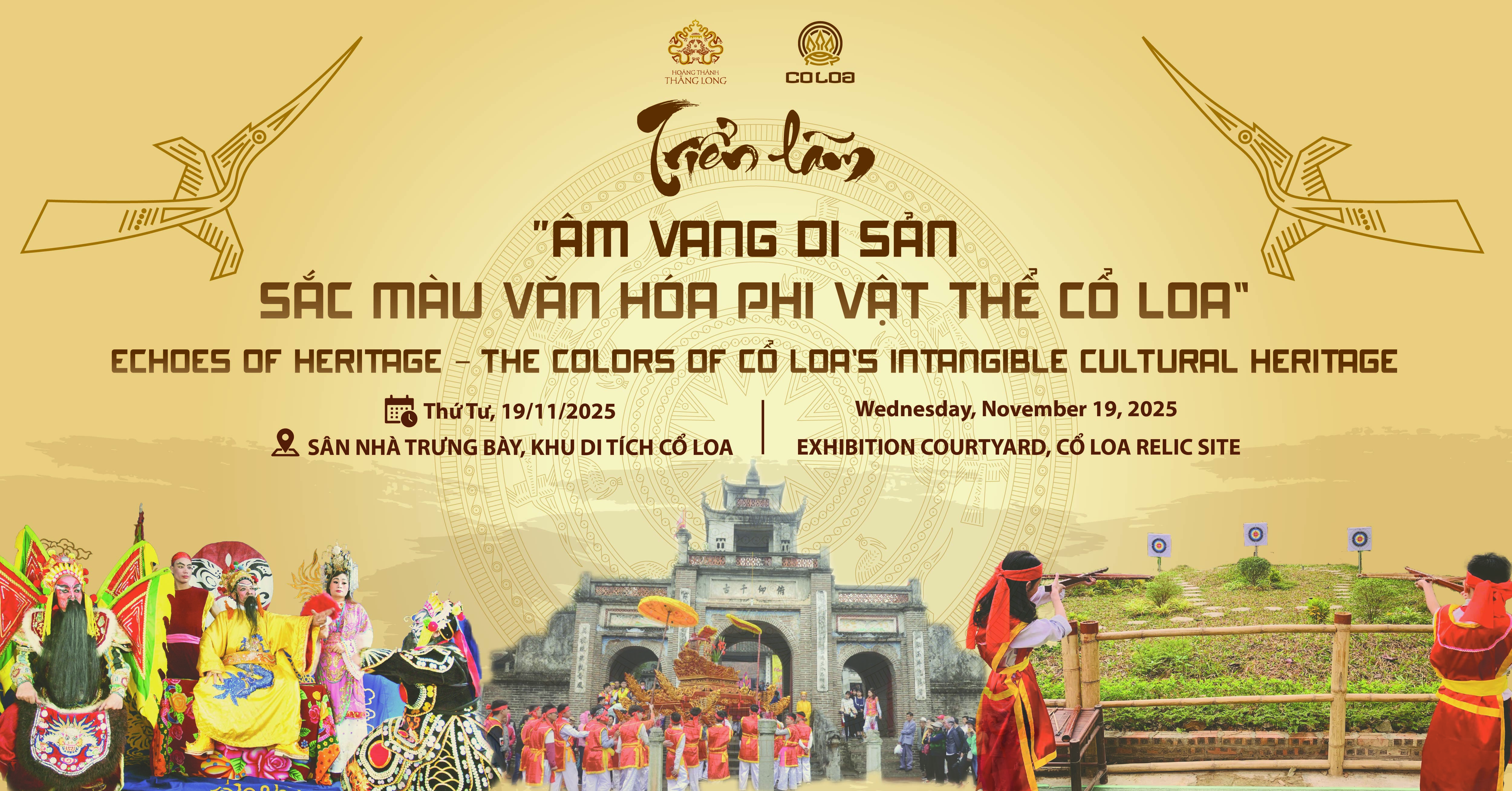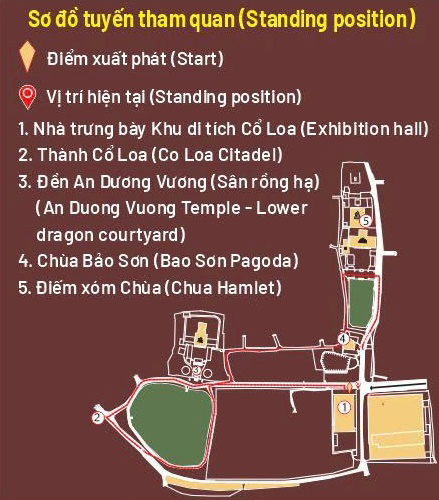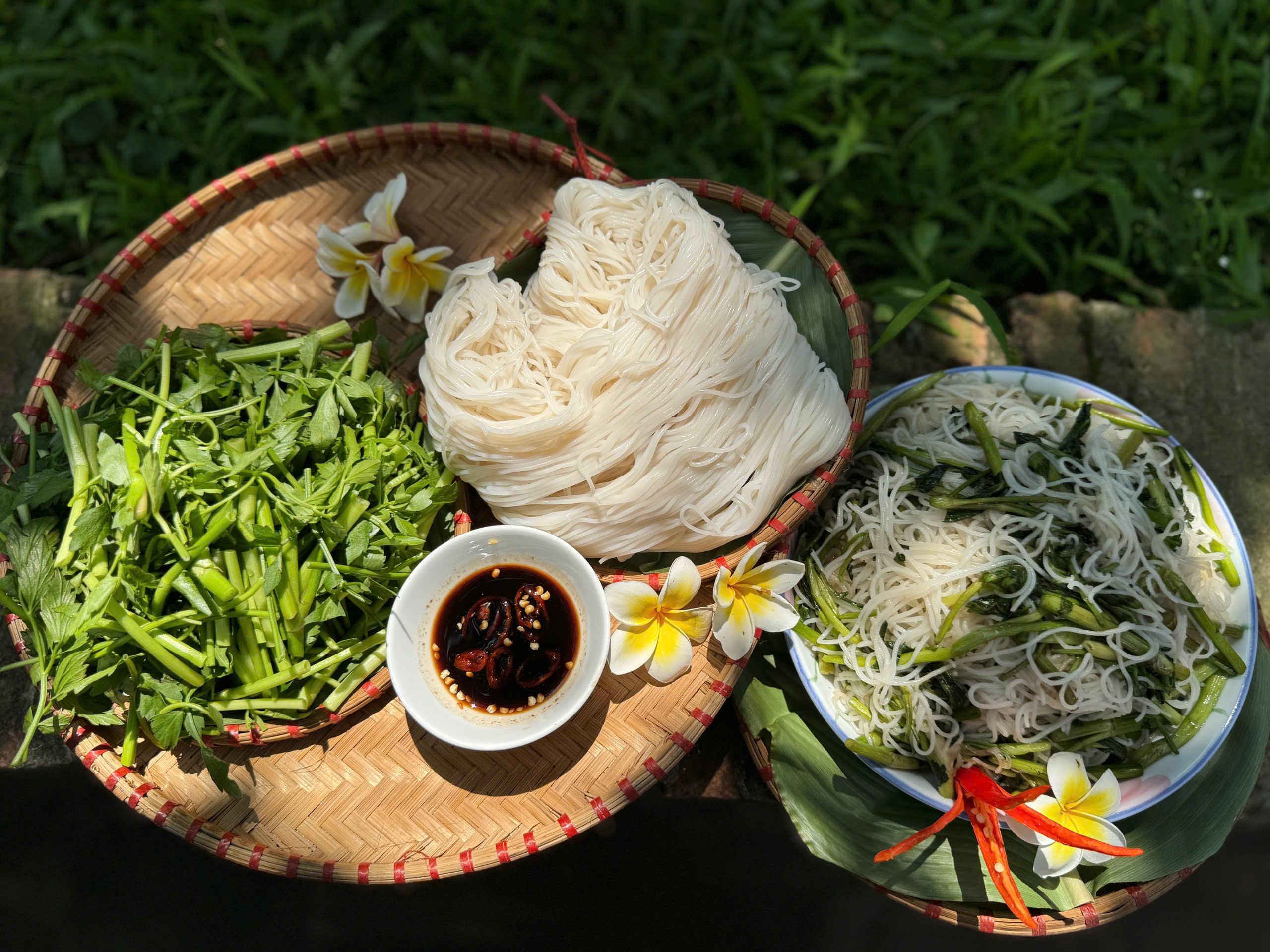Văn Thượng village, Xuân Canh commune, Đông Anh district, Hanoi is a village in the "Bát xã hộ nhi" worshiping King An Dương. After the Cổ Loa festival on January 6, on January 8, the people of Văn Thượng village together organize the village's traditional festival to commemorate and honor King An Dương, who unified the two tribes of Âu Việt and Lạc Việt, establishing the state of Âu Lạc.
To participate in the “Bát xã hộ nhi” festival (Cổ Loa festival) on January 6 and organize the village festival on January 8, preparations begin from the end of November and the beginning of December. The first step is to elect the "Thủ hiệu" who plays the drums and gongs. In the village, they must appoint people who are ethical and have perfect family, according to the village's standards. “Thủ hiệu” is wearing a turban, and the feet are wearing “Ký Long” shoes.
Besides, to prepare for the “Bát Xã Loa Thành” festival, Văn Thượng village also established a number of teams such as: the “quân chầu” team (servers), the flag dancing team, the eight treasure bronze procession team, the “bát âm” team, and the flag procession team, “Ban bài sáp” - Procession steering committee. At the same time, the village also selected a number of young men who were healthy and without deformities to carry the palanquin (called “quân chầu”) and selected a number of young men and women to carry the flag in the procession. In addition, the village also chooses a person to read oration, who has a good appearance, voice, a happy family, and free from funerals.
Like the villages participating in the procession at the “Bát xã Loa Thành” festival, Văn Thượng village prepares 2 palanquins:
+ “Bát cống” palanquin: bring offerings to the King
+ “Văn” palanquin (On the afternoon of January 5, the village elders brought the palanquin to Princess Mỵ Châu Temple to welcome the princess back to the communal house).
One of the important contents in the village's preparation for the festival is the establishment of the Sacrifice Committee and the Sacrifice Team. The men's Sacrifice Team consists of elderly men in the village over 50 years old, whose families must be free from mourning and still healthy and alert, and have been selected within the year. Consists of 24 elders, including the sacrifice leader, officials, and the assistants. The women's sacrifice team also includes women aged 45 years and older, who have happy families. Consists of 10 people, including 1 leader (wearing a red shirt) and 9 officials (wearing yellow shirts).
Preparations for the village festival are organized by the village government and organizations (Elderly Association, Youth Union, Women's Union, Veterans Association...). In particular, the Elderly Association is responsible for performing the ritual, while the Youth Union and the Women's Union play the role of recording contributions.
Offerings include: incense, fruit, flowers, wine, joss paper.
From the afternoon of January 5, the village elders brought the palanquin to Princess Mi Chau Temple to welcome the princess back to the communal house. Early in the morning of January 6, the palanquin of Văn Thượng village was carried to the yard of Thuong temple (the temple of King An Dương) where the “Bát xã Loa Thành” festival was held. During the procession, the Văn Thượng village palanquin was honored to be in second place after Cổ Loa. Next are the palanquins of Mạch Tràng, Sằn Giã, Ngoại Sát, Đài Bi, Cầu Cả and Thư Cưu. At the sacrificial ceremony of “Bát xã Loa Thành”, the representative of Văn Thượng village was honored to perform the "Độc chúc" (read the oration) task.
After participating in the procession at the Cổ Loa festival, the authorities and people of Văn Thượng village returned to celebrate the festival in their village on January 8.
On the morning of January 8, in a sacred and solemn setting, at Văn Thượng communal house, the village head of Van Thuong reads the opening speech of the festival, introducing the history of formation and development of Văn Thượng village, Xuân Canh commune. as well as highlight the village’s participation and contribution to the "Bát xã hộ nhi" festival.
In the past, the communal house was the place to organize Văn Thượng village’s festival. According to the village elders, it is not clear when Văn Thuợng communal house was built, only that the communal house has existed for a long time. In 1949, due to the war, the communal house was destroyed and all the worship objects were burned.
Văn Thượng Communal House - where traditional festivals are held
In 1990, the Văn Thượng village government built the village cultural house on the foundation of the old communal house. In 1992, the village communal house was rebuilt, 200m from the old location. In 2007, Văn Thượng Communal House was rebuilt, larger and more spacious. Funds from resettlement sources to build National Highway 5.
Van Thuong village communal house has a structure in the shape of Chinese word "丁", the Grand Ceremonial Hall consists of 5 main compartments, 2 hip compartments and a sanctuary. The communal house's previous artifacts were completely burned. The existing artifacts are new items made in 2007, including: Altar throne, altar tray, incense burner, horizontal board, parallel sentences, long sword, altar horse, wooden door, bowl and “bát cống” palanquin, “văn” palanquin, stone stele... In addition, the communal house also has 02 conferments:
- The second conferment on July 25, the reign of Khai Dinh 9 (1924), was given to Văn Thượng village, Lục Canh commune, Đông Anh district, Phúc Yên province to worship King An Dương. God helped save the people, showing his merit. A conferment was granted, allowing worship as before.
- The first conferment was on July 25, the reign of Khai Dinh 9 (1924), the content was to grant Văn Thượng village, Lục Canh commune, Đông Anh district, Phúc Yên province to worship Princess Mị Châu as a god and deserves to be titled Trai Tinh, Dực Bảo Trung Hưng, Trung Đẳng God.
The sacrificial ritual that takes place at the Văn Thượng village festival is almost the same as at the Bát xã Loa Thành festival, divided into three stages: “Sơ hiến, Á hiến and Trung hiến” called “Tam hiến” (“hiến” is wine offering).
The ceremony began with the chant: " Khởi chinh cổ ", immediately the drums and gongs played a long series, for every drum beat followed by a gong sound, each time faster and faster, then the musicians started the music. At the end of the music, the officials are responsible for checking the offerings before offering them to the king. The two people leading the ceremony, followed by two "nội tán" holding candles, went inside to check the offerings. After checking the offerings, it is the turn of the celebrant and his officials to perform their duties according to the words of "Đông xướng", "Tây xướng" and the command of the drums and gongs. At this time, the celebrant and his asistants still stood strictly in two rows in the ceremony yard. The celebrant is the one who carries out the important responsibility of worshiping the gods, so before entering the ceremony, he must perform the "Cleansing" ritual, which means washing his hands in a basin of ginger water placed at the side of the yard. “Đông xướng” chants: " Chủ tế quan tựu vị, bồi tế viên tựu vị", then the celebrant and the "bồi bái" and "bồi tế" (celebrant’s asistants) take turns taking their positions on the mat. The ceremony has the purpose of welcoming and inviting the gods to attend the festival and enjoy offerings, and is also an opportunity for villagers to praise the god, express gratitude to him and pray for him to protect the villagers.
The first ritual of the ceremony is offering incense. The assistant lights incense, gives it to the celebrant to perform the ceremony, then the celebrant returns the incense to the assistant and these two bring the incense into the sanctuary to offer to the god. Outside, "Đông xướng" chanted: "Nghênh thánh đế cúc cung bái", the celebrant and his assistants knelt down and bowed 4 times according to the command of the drums and gongs. Each time “Đông xướng” shouted "Bái", everyone knelt down together and “Tây xướng” shouted "Hơn" and everyone stood up. After completing the incense offering ceremony, everything returns to its original position.
The second ritual of the ceremony is offering wine. This is the main and longest ritual in the ceremony. "Hành sơ hiến lễ" is the first wine offering ceremony. Hearing the chant "nghệ tửu tôn sở ", the two other assistants went to the table to receive the wine and cups and then turned over the wine cover towels. The two assistants and the celebrant went up to the first mat, in front of the incense burner, and “Đông xướng” chanting "nghênh thánh đế vị tiền". When arriving at the incense altar, the two people leading the ceremony and the two “nội tán” stand on both sides of the incense altar while the celebrant and his assistants kneel in front of the altar. The two assistants pour wine into cups, then the celebrant performs the “tiến tước” ceremony, that is, raises the wine to his eyebrows and then returns it to the assistants. When “Đông xướng” shouted "tiến tước", two assistants took the wine and cups into the sanctuary, the “thủ từ” there picked up the wine and placed it on the altar. The two people leading the ceremony and two “nội tán” carry candles in front, and two “bồi tế” holding wine and cups follow behind through the two eastern doors. Outside, the celebrant and “bồi bái” kneel and worship three times, according to the command of the drums and gongs and the chants "bái" and "hơn" of Đông xướng and Tây xướng. During the offering of wine, four young men holding buntings stood at the end of two rows of officials dancing and waving the flags. At the same time, “dàn đồng văn” also played music to entertain while the God enjoyed the wine.
The important ritual of the ceremony is “đọc chúc” (reading the oration). All officials and people stood solemnly to listen to the oration. “Đông xướng” chanted: "Chủ tế quan, đọc chúc viên tựu vị" then two people leading the ceremony and two “nội tán” went first, then a “bồi tế” carrying the oration went to the right, the reader went to the left and the celebrant went in the middle to the front of the incense burner to read the oration. In front of the incense altar, the celebrant, the “bồi tế” and the oration-readers kneel, when “Đông xướng” chants "giai quỵ", all the assistants and people kneel to listen to the oration-reading. “Bồi tế” passes the oration to the celebrant, then the celebrant bows three times before the Holy Emperor and passes it to the reader. After reading the oration, the oration was seriously placed on the altar and all officials kneel three times and then stood up following the chants of "bái" and "hưng" from the “Đông xướng” and “Tây xướng”.
The second and third rounds of wine are offered immediately after and the ceremonies are exactly the same as the first. During the second round, the celebrant and the assistants only kneel once.
The final ritual of the ceremony is “hóa chúc” (burning the oration paper). The celebrant goes up to the incense altar and kneels three times to ask for “hóa chúc”. The oration is burned right in front of “bồi tế”, “bồi bái” and “nội tán”, “Đông xướng” and “Tây xướng” to perform the thanksgiving ceremony. The whole group lined up seriously in the yard, in front of the altar and the large incense burner, then knelt and bowed nine times following the instructions of the drums and gongs, and when two drums sounded, they knelt and bowed, and after one drum sound, they stood up. Finally, there are three bows.
Along with the solemn ceremony, at the village cultural house and stadium, the festival took place with rich and exciting folk game activities that attracted a large number of Văn Thượng villagers and people of neighboring communes. The games take place from January 7 to January 8. Folk games at the festival include: tug of war, rice cooking competition, cockfighting... In addition, today's festival also has other competitions such as: volleyball, soccer... Playing tug of war, jumping on the sack and cooking rice are prominent games, attracting a large number of people to participate.
Prizes for games of small value are mainly for morale encouragement. Participating in games helps people have fun and get closer together.
On the evening of January 7, at the village cultural house, musical performances also take place, with smooth and loving folk songs that contribute to beautifying and enriching the village festival.
Along with the hamlets and villages of “Bát xã Loa Thành”, folk games at the Văn Thượng village festival are extremely rich and diverse spiritual activities for the people here. Everywhere you can see the games and competitions of young men or the smooth mandarin melodies of “liền anh” and “liền chị” during festivals. We feel like we are immersed in the life of a simple worker, there is no longer distance, only closeness and solidarity with each other. On the competition fields, or the stage of the cultural house, it is always full of laughter and cheers... Văn Thượng village festival and Bát Xã Loa Thành festival really bring people together through solemn ritual ceremonies and simple folk games.
MANAGEMENT DEPARTMENT OF CỔ LOA VESTIGE SITE








